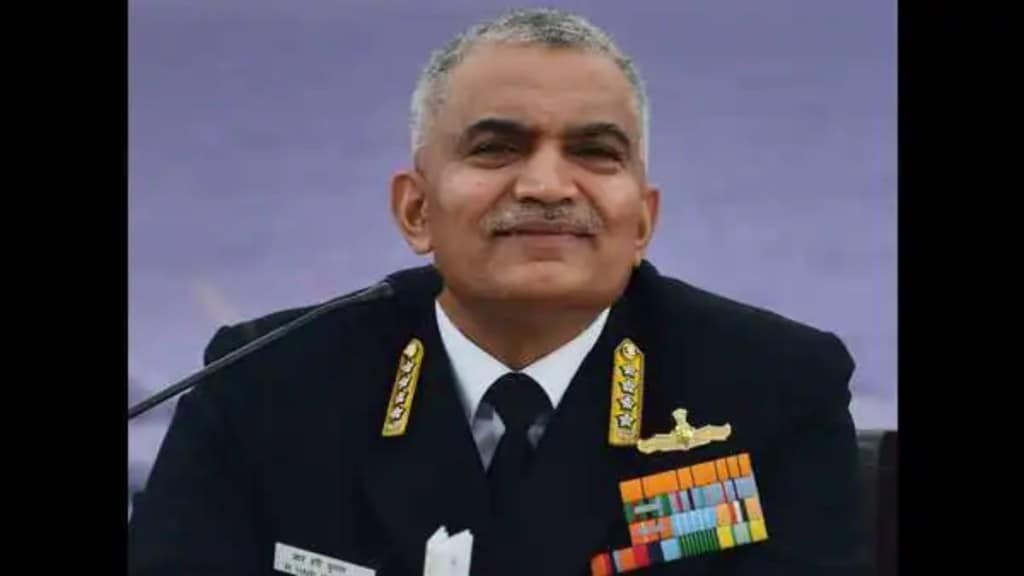The Indian Navy has appointed the first woman commanding officer in a naval ship in sync with its philosophy of ‘all roles-all ranks’ for female personnel.
Navy chief Admiral R Hari Kumar at the annual media interaction said on Friday: “The Navy has appointed the first woman commanding officer in a naval ship. The Navy has remained a ‘Combat-ready, Credible, Cohesive, and Future Proof’ force enabled by what we call our ‘ships first’ outlook where every single action that we take is aimed to enable our women and men in operational units to perform their duties very well.”
On the operational front, the Navy’s sheer footprint of deployments has been satisfying as its ships have been persistently present across the Indo Pacific.
The chief did not disclose the name of the lady officer who will be commanding a ship based in Western Seaboard, however added: “The lady officer has to go through the pre-commission training before she takes over as CO.”
Women Agniveers
Also, “The overall strength of women Agniveers has now crossed the 1,000 mark. These statistics stand testament to our philosophy of ‘all roles, all ranks’ approach to deployment of women in the service,” the chief added.
Admiral Hari Kumar said that “Our first batch of Agniveers graduated from the premier training establishment INS Chilka in March this year. Importantly, this batch of Agniveers included 272 women trainees and going further, the present batch of Agniveers has a total of 454 women.”
“With the third batch of Agniveers joining at INS Chilka, the overall strength of Women Agniveers has now crossed the 1000 mark.”
Women in the Armed Forces across the Globe
On the international stage, opportunities for women in the military, especially in navies, have been steadily expanding. Several armed forces, once limited to assigning women to support and administrative roles, now witness their ascent to the highest echelons of decision-making. In the United States, this transformation is evident, with 2022 Defence statistics revealing that one in every six active-duty service members is a woman.
A pivotal moment in this global shift occurred on July 21 when President Joe Biden nominated Admiral Lisa Franchetti as the US Chief of Naval Staff. With a career spanning 38 years, Admiral Franchetti’s trajectory mirrors the broader integration of women into the US armed forces.
A crucial turning point for gender inclusivity in the Indian Armed Forces occurred in February 2020 when the Supreme Court mandated gender-neutral terms and conditions of service. This groundbreaking decision facilitates women joining the military directly after school, securing senior positions, permanent commissions, and access to combat roles. Presently, the Indian Army boasts 7,093 women across various ranks, the Navy has 748 women officers (including medical and dental officers), and the Air Force features 1,636 women officers (excluding the medical and dental branches).
Remarkably, what was once deemed implausible is now a reality—women officers studying at the National Defence Academy, India’s premier military institution. Furthermore, as of January this year, women officers have assumed command roles in the Indian Army, making them eligible to lead units and troops—a pivotal step towards more senior positions. Although achieving gender neutrality and parity in the Indian Armed Forces is an ongoing process, these progressive steps are commendable.
Internationally, countries like Canada, France, and Germany boast substantial percentages of women in their armed forces. Australia, China, and the United States also have women contributing to military roles, with select countries permitting women to serve in combat positions.
Women in the military have rightfully earned equal rights to military honors, stars, stripes, and medals, standing shoulder to shoulder with their male counterparts. Noteworthy milestones include Brazil allowing women into combat training in 2016, the United Arab Emirates authorizing a female fighter pilot to participate in a mission against the Islamic State in Syria in the preceding year, and South Korea opening combat positions to women as early as the 1990s.
The global landscape has seen China’s first class of female fighter pilots graduating in 2009, Germany opening combat roles to women in 2001, and France featuring almost 2 percent of women in the combat infantry. In 1985, Norway emerged as a trailblazer, becoming the first nation to open all combat jobs to women, while Israel embraced women in combat roles in 1995, and the Philippines followed suit in 2006.
Insights from a US Army officer’s experience in Afghanistan highlight the indispensable role women play in combating cultural warfare. In warzones, where local women often hold crucial information, it is women officers who become instrumental in convincing complicit locals to break their silence and confederate.
Recognizing the indispensable role women play in peacekeeping, both domestically and internationally, it is incumbent upon more countries to prioritize gender balance within their armed forces. The ongoing global trend toward greater inclusivity signifies a positive stride toward building stronger, more diverse defence forces.


